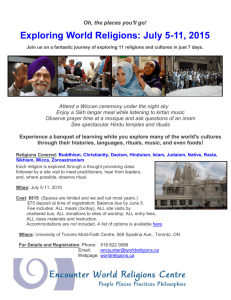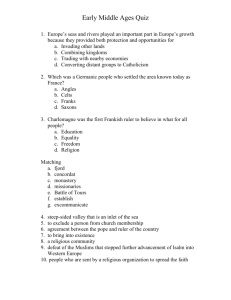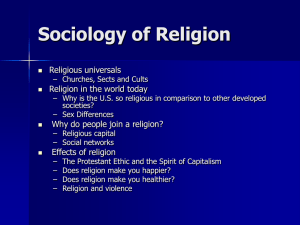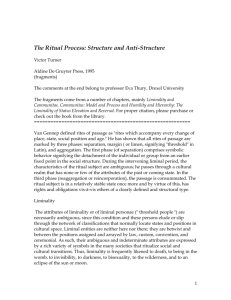Basic Traits in Religious World Views
advertisement
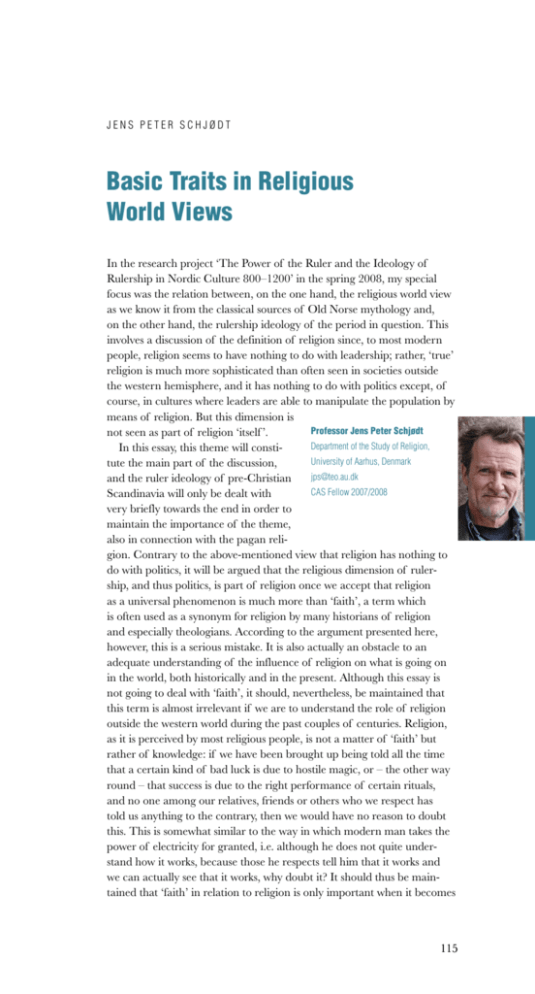
J ens P eter S chjødt Basic Traits in Religious World Views In the research project ‘The Power of the Ruler and the Ideology of Rulership in Nordic Culture 800–1200’ in the spring 2008, my special focus was the relation between, on the one hand, the religious world view as we know it from the classical sources of Old Norse mythology and, on the other hand, the rulership ideology of the period in question. This involves a discussion of the definition of religion since, to most modern people, religion seems to have nothing to do with leadership; rather, ‘true’ religion is much more sophisticated than often seen in societies outside the western hemisphere, and it has nothing to do with politics except, of course, in cultures where leaders are able to manipulate the population by means of religion. But this dimension is Professor Jens Peter Schjødt not seen as part of religion ‘itself ’. Department of the Study of Religion, In this essay, this theme will constiUniversity of Aarhus, Denmark tute the main part of the discussion, jps@teo.au.dk and the ruler ideology of pre-Christian CAS Fellow 2007/2008 Scandinavia will only be dealt with very briefly towards the end in order to maintain the importance of the theme, also in connection with the pagan religion. Contrary to the above-mentioned view that religion has nothing to do with politics, it will be argued that the religious dimension of rulership, and thus politics, is part of religion once we accept that religion as a universal phenomenon is much more than ‘faith’, a term which is often used as a synonym for religion by many historians of religion and especially theologians. According to the argument presented here, however, this is a serious mistake. It is also actually an obstacle to an adequate understanding of the influence of religion on what is going on in the world, both historically and in the present. Although this essay is not going to deal with ‘faith’, it should, nevertheless, be maintained that this term is almost irrelevant if we are to understand the role of religion outside the western world during the past couples of centuries. Religion, as it is perceived by most religious people, is not a matter of ‘faith’ but rather of knowledge: if we have been brought up being told all the time that a certain kind of bad luck is due to hostile magic, or – the other way round – that success is due to the right performance of certain rituals, and no one among our relatives, friends or others who we respect has told us anything to the contrary, then we would have no reason to doubt this. This is somewhat similar to the way in which modern man takes the power of electricity for granted, i.e. although he does not quite understand how it works, because those he respects tell him that it works and we can actually see that it works, why doubt it? It should thus be maintained that ‘faith’ in relation to religion is only important when it becomes 115 Basic Traits in Religious World Views possible to doubt the basic religious ideas. In pre-modern societies, it was as irrelevant as if, in the modern world, we spoke about ‘faith’ in relation to electricity, at least for the vast majority of the population. To return to religion, it seems to me that we must accept two prerequisites if we are to recognise a phenomenon as religion. The first of these is that the world view of the societies and individuals we designate as religious consist of at least two ‘worlds’: this world and the other world. On the one hand, we have the world in which we live, ‘this world’, which is characterised by technical skills in order for us to survive. If we do not know how to make a fish trap, we cannot catch fish and may die of starvation; fortunately, however, it is possible for almost everyone to learn these skills. In the past, many societies were characterised by a very low degree of division of labour, and most men were able to do what men were supposed to do, and most women were able to do what women were supposed to do. In later societies with a higher degree of division of labour, we were not all able to do everything required in order to survive, but the necessary technical skills were handled by specialists. If they were skilful enough, things would work – at least most of the time. Sometimes, things did not work out as they should, no matter how skilful you were: the fish did not go into the traps, the canoe would sink regardless of its construction, etc. Therefore, on the other hand, there had to be powers beyond the power of ordinary man. This ‘beyond’ we can, in religions, designate ‘the other world’, which is normally characterised as being opposite in many ways to this world. Thus it is often imagined that there is no death in the other world, there is no darkness, the beings there do not have to work in order to survive, they have powers that no man possesses and so forth. Further, in this other world, there are powers responsible for the things that are beyond the control of man, but they may, nevertheless, be manipulated by certain people in society, i.e. people who have special skills which cannot be obtained by everyone because they are dependent on the other world. This brings us to the second prerequisite for speaking about religion, namely, that some communication must take place between the two worlds. If such communication does not take place, we should not speak of religion but rather of some sort of philosophy. This religious communication takes place in rituals which we may define as actions meant to manipulate the beings of the other world, such as gods, spirits, demons, etc., beings that are able to do good as well as bad. In order to succeed, this communication is very often, although not always, handled by certain specialists, i.e. people trained in this communication, such as priests, magicians, shamans, etc., specialists that we may characterise as ‘liminal persons’. There are individual as well as collective rituals, and the latter are mostly performed for the benefit of society as a whole, for instance, in order to secure a good harvest, victory in battle, etc. And in many cultures, the person who is most responsible for the wellbeing of society is the ruler, to whom I will return in a moment. This world view with at least two worlds and the idea of possible communication between them can be found in any religion, and we could add a third characteristic, namely, that in all religions, the notion of the other world has some consequences on the way people act. If, for instance, : Actually, in most religions there are a number of other worlds: the world of the gods, that of demons, that of the dead, that of anonymous groups of beings promoting fertility etc. This, of course, differs very much from one religion to another. 116 Basic Traits in Religious World Views in the beginning of the world, the gods had decided that men and women should not do the same work, this had to be accepted forever after; or if the forefathers were especially connected to some species, then we, the descendents, are still connected to these species such as we see them in the so-called totemistic societies. But we do not only meet these consequences at the sociological level. Also at the psychological level, the notions of the other world are important, for instance, in connection with ethics and conscience, causing people to want to behave in certain ways in order to feel good. All this can be illustrated with the following figure: The religious world view The Other World Liminal zone This World One advantage of this model of religion is that it can explain the relationship between many, apparently quite distinct, phenomena that we intuitively connect with religion, such as myths, rituals, totemism, priests, spirits, morality, sacrifices, etc. All these phenomena can be divided into three categories: (a) phenomena which are prerequisites for our way of living, i.e. things taking place in the other world and perhaps a long time ago; these prerequisites are most often transmitted in different narrative genres, the most important of which is myth; (b) communication phenomena, i.e. actions which endeavour to cross the liminal zone between the two worlds; and finally, (c) consequence phenomena, i.e. social and psychological facts, which are explained as consequences of what happens in the other world and in the communication between this and the other world. We may thus extend the figure above with some examples from the vocabulary of religion: Myths, gods, the dead, cosmology, etc. Rituals, prayers etc. Totemistic clans, ethics. The organisation of society. Sacred rulers : ‘Liminal’, from Latin limen, ‘threshold’, i.e. the borderline between two different spheres. The importance of the term in anthropology and history of religions is due to the British anthropologist Victor W. Turner, who used it in many important publications, especially in The Ritual Process. Structure and Antistructure from 1969. 117 Basic Traits in Religious World Views Now, in the light of this model, it seems quite in accordance with the very structure of religion that the leader of a religious society, who, as all leaders, at least to some extent, is responsible for the wellbeing of his people, must have some privileged access to the beings of the other world because otherwise he cannot perform his duties. A ruler, seen as a kind of ‘supernatural’ human being, is thus not added to religion ‘pure’ but, on the contrary, is at the very heart of religion since the wellbeing of society and individuals is what religion is basically all about. If we now turn to the pre-Christian religion of the North, it is in the nature of things, so to speak, that the ruler, whether king or chieftain, was seen as a mediator between this world and the other world. In most cultures, there were/are basically two ways of establishing this relationship, either the ruler was born as an outstanding person, or/and he ritually became such a person (in Christianity we thus have the notion of Rex Iustus – a just king whom God himself had chosen because of his moral standards). In Scandinavia, both possibilities were at hand. Thus sources tell us that the king was a descendant of some god, but it is also related that he was ritually initiated to that very god so that the god became a kind of guardian spirit for the king, helping him in battles and teaching him various kinds of magical skills. The scope of this paper does not allow me to go deeper into all the questions that may be raised in connection with the sources for Old Norse religion and mythology. What I have aimed at here is primarily to show that the modern idea of religion as something more or less ‘private’ is not in accordance with religions in archaic societies. ‘Private’ religion has evolved in modern societies for various reasons, but ‘true’ or ‘archaic’ religion, i.e. religion as a universal phenomenon, will inevitably include a mediation between this and the other world performed by religious specialists, among whom, viewed ideally, the most outstanding one is the person who represents the totality of the society: that is, the ruler. : The source situation concerning Old Norse religion is rather complicated and has caused much disagreement among the scholars. In short we have, on the one hand, what we may call contemporary sources which are mostly of an archaeological nature, and on the other hand, we have the more recent sources from the middle Ages, e.g. the Icelandic sagas. Whereas the first group is very difficult to interpret as regards religious notions, the second group has often been dismissed by scholars because the texts are for the most part written a long time after the conversion to Christianity. Due to the lack of space, it is not possible to delve into these source-critical problems, but I have dealt with the problems at other places, for instance, in my book Initiation between Two Worlds. Structure and Symbolism in pre-Christian Scandinavian Religion, from 2008, pp. 85–107. : Sometimes it is said to be Odin, and sometimes Frey. There may be explanations for this apparent contradiction, which, however, are beyond the scope of this brief paper. 118

